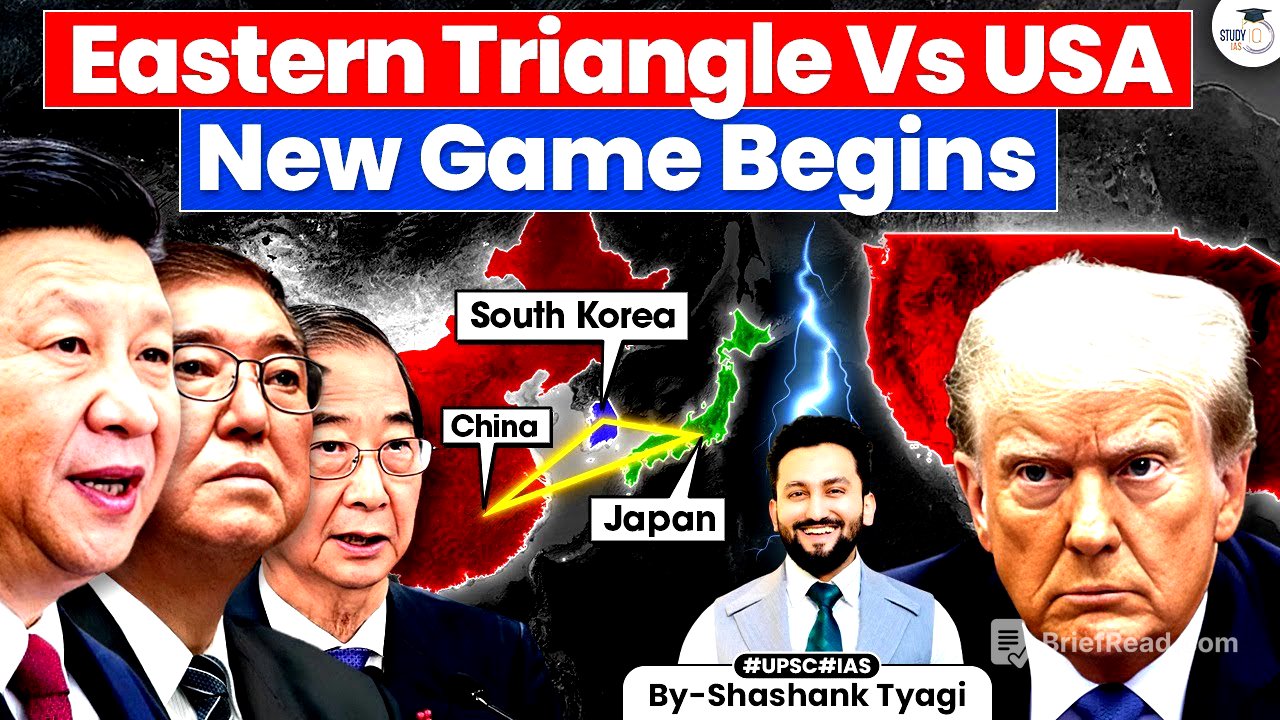TLDR;
This video analyzes the evolving dynamics between the USA, Japan, South Korea, and China, focusing on economic and geostrategic shifts. It examines historical contexts, trade relations, and the impact of US policies on these relationships, highlighting the potential formation of a trilateral axis between China, Japan, and South Korea.
- The video explores the historical context of US-Japan relations post-World War II, including the Plaza Accord and its economic impact on Japan.
- It discusses the alliance between the US and South Korea, the economic tensions arising from trade deficits, and the implications of US tariff policies.
- The analysis covers the potential realignment of Japan, South Korea, and China, driven by economic interests and concerns over US trade policies, and its possible impact on US influence in the region.
Introduction: Changing International Relations [0:01]
International relations are subject to change, exemplified by the potential trilateral axis forming between China, Japan, and South Korea. This development challenges the traditional alliances, particularly the US-Japan relationship, where Japan has historically been a key ally and a strategic frontier for the US in the Pacific. The video aims to analyze these dynamics, exploring the history of Japan, US-Japan relations post-World War II, and the current dynamics involving South Korea.
Historical Context: US-Japan Relations After World War II [2:37]
Following the devastation of Hiroshima and Nagasaki, Japan became one of the poorest countries. The US took responsibility for Japan's administration under a peace treaty, modernizing the country and establishing military bases there to counter threats from the region. Japan transformed into the second-largest economy through its education system and pro-growth policies, with Japan becoming the biggest foreign investor in the US. However, the US, wary of Japan's growing economic power, orchestrated the Plaza Accord, signed at the Plaza Hotel in New York, to depreciate the dollar and appreciate the Yen currency.
The Plaza Accord and Japan's Economic Decline [4:50]
The Plaza Accord led to the appreciation of the Yen, which negatively impacted Japan's export-led economy. The stronger Yen made it more difficult for foreign investment and reduced the profitability of Japanese exports. The US then declared Japan's economy an asset bubble, leading to a burst that significantly reduced Japan's growth rate. Despite efforts by Shinzo Abe with "Abenomics," Japan struggled to regain its previous economic strength, highlighting the importance of sustaining work and networking during tough times.
Japan's Strategies for Economic Survival [7:12]
To combat economic challenges, Japan focused on maintaining customer networks through services like car insurance and developed the Kiretsu system. Kiretsu is a unique model involving a network of manufacturers, distributors, and suppliers who mutually buy stakes in each other, ensuring quality, timely delivery, and cost reduction. This system, which was not prevalent in the US, gave Japan a competitive advantage. Additionally, during the oil crisis in 1973, Japanese companies captured market share by producing small, efficient cars with high quality and low costs, utilizing Just in Time Inventory Management to reduce capital costs.
US-Japan Indispensability and Trade Tensions [11:28]
Despite the indispensable relationship between the US and Japan, the US imposed a 25% tariff on Japanese automotive exports. This decision disregards Japan's role as a strategic ally, standing as a wall against threats from China, Russia, and North Korea in the East China Sea. The interoperability between US and Japanese forces is considered one of the best, yet Trump's policies sideline traditional foreign policies, prompting Japan to re-examine its strategies.
US-South Korea Alliance and Trade Deficits [15:36]
Following World War II, the Korean Peninsula was divided into North and South Korea. The US supported South Korea, maintaining a military presence to counter communism. South Korea has since become a major player in electronics and semiconductors, with companies like Samsung and SK Hynix holding a significant global market share. Despite this, the US has a growing trade deficit with South Korea, leading to potential tariff wars.
The Fab Four and US Trade Policies [20:58]
The "Fab Four," consisting of South Korea, Japan, Taiwan, and the USA, formed a semiconductor grouping to ensure progress in the industry and prevent China from gaining a strategic advantage. However, the US continues to wage tariff wars against its allies, causing disarray and potentially threatening South Korea's interests. If the US imposes high tariffs on China, South Korean component suppliers to Chinese manufacturers like Apple could suffer, pushing South Korea to seek closer ties with China.
The Eastern Triangle and Shifting Alliances [23:21]
The potential US-China competition threatens South Korea's interests, leading to the formation of an "Eastern Triangle" with China and Japan. Trump's policies overlook the importance of US, Japan, and South Korea partnerships in the Indo-Pacific region, prioritizing transactional relationships over regional alliances. This shift may strengthen the trilateral relationship and result in counter tariffs against the US, harming the overall economy.
Japan's Independent Stance and Closer Ties with China [24:51]
Japan is increasingly moving away from the US, as seen in its stance on Palestine's UN membership and its criticism of Israel's actions in Gaza. The new Japanese PM is aligning more closely with China, increasing visits and fostering a better relationship with Xi Jinping. This shift marks a departure from Abe's policy of balancing US-China and US-India relations. Additionally, Japan and China are increasing people-to-people exchanges with visa-free entries and long-term visas, which could be a concern for the US.
China's Assertiveness and Japan's Strategic Response [26:52]
Despite growing ties with Japan, China is not backing down on its assertive actions, such as its claims over the Sankaku Islands. Japan recognizes that it needs to develop relationships with potential threats, making the Eastern Triangle more feasible. Japan is also diversifying its economic interests by investing in India and pursuing the Asia Africa Growth Corridor, reducing its dependence on China and the US.
Conclusion: Trump's Perspective and Global Implications [29:01]
Trump's perspective prioritizes the US, aiming to decrease the country's debt through his strategies. However, this approach has geo-strategic implications that need careful management. The video concludes by promising a detailed analysis of Trump's views on China, the Indo-Pacific, and the South China Sea in a future video.








